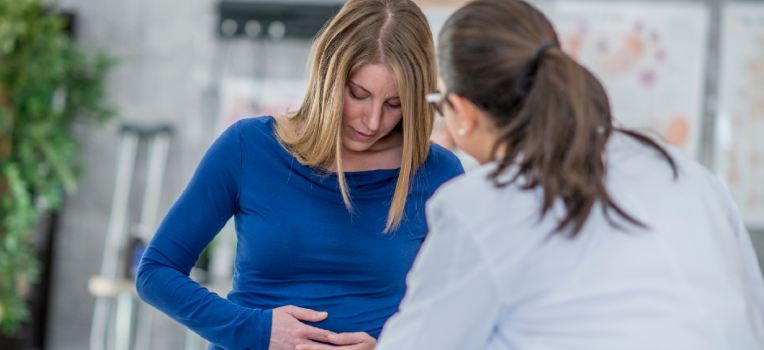Fibroids and polyps are typically benign (non-cancerous) growths in a woman’s uterus. While they may be benign, they may cause problems such as infertility or recurrent pregnancy loss. Women may also experience pelvic pain, pressure, or changes in their menstrual cycles as a result of fibroids.
Fibroids
Fibroids are benign tumors arising from the smooth muscle of the uterus. Fibroids are described by their location in the uterus—within the uterine wall, extending into the uterine cavity, or on the surface of the uterus.
There are three kinds of fibroids:
- Submucosal (sub-myoo-KOH-zuhl) fibroids grow into the uterine cavity.
- Intramural (ihn-truh-MYOOR-uhl) fibroids grow within the wall of the uterus.
- Subserosal (sub-suh-ROH-zuhl) fibroids grow on the outside of the uterus.
Health care providers may refer to fibroids as tumors, leiomyomas or myomas. These masses are not cancerous and do not require treatment unless they are causing symptoms, such as pelvic pain, bleeding, or heavy or uncomfortable menstrual periods.
It is estimated that as many as 1 in 5 women of childbearing age have uterine fibroids. They are most often found in women over age 30, are rarely seen in women under 20 and are more common in African-Americans than Caucasians. And while many women do not experience symptoms from fibroids, any type of fibroid can impact reproductive function and may cause infertility or miscarriage. Although it is not known what causes uterine fibroids, they grow in response to the hormone estrogen. Fibroids, therefore, often continue to grow throughout a woman’s reproductive years while she has normal circulating levels of estrogen. At the onset of menopause, when hormone levels drop, fibroids are likely to decrease in size.
Polyps
Endometrial polyps are small growths within the endometrium, or the lining inside the uterus. They are common and are most often found in women over age 20. Young women who have not yet started menstruating rarely have polyps.
A woman can have one or several polyps. Although they are usually not cancerous, all polyps should be evaluated by an Ob/Gyn or fertility doctor. Polyps are easy to remove and do not usually grow back.
The cause of endometrial polyps is not clearly understood. They might develop from overgrowth of the endometrium, or hyperplasia, or by certain medications. Researchers believe polyps may also be an abnormal response to an increase in estrogen levels.
Many polyps do not interfere with the ability to get pregnant. However, large or multiple polyps can sometimes cause problems with fertility or result in recurrent miscarriage.
If you’re experiencing recurrent miscarriages or suspect an infertility condition, you should consider consulting with a fertility specialist.
Dr. Taraneh Gharib Nazem is Senior Fellow in Reproductive Endocrinology and Infertility at the Icahn School of Medicine at Mount Sinai/Reproductive Medicine Associates of New York. She is a board-certified Obstetrician Gynecologist. Dr. Nazem completed her residency in Obstetrics and Gynecology at the New York University School of Medicine, where she was elected administrative chief resident and graduated with the Robert F. Porges Honor Resident Award, for outstanding performance.
